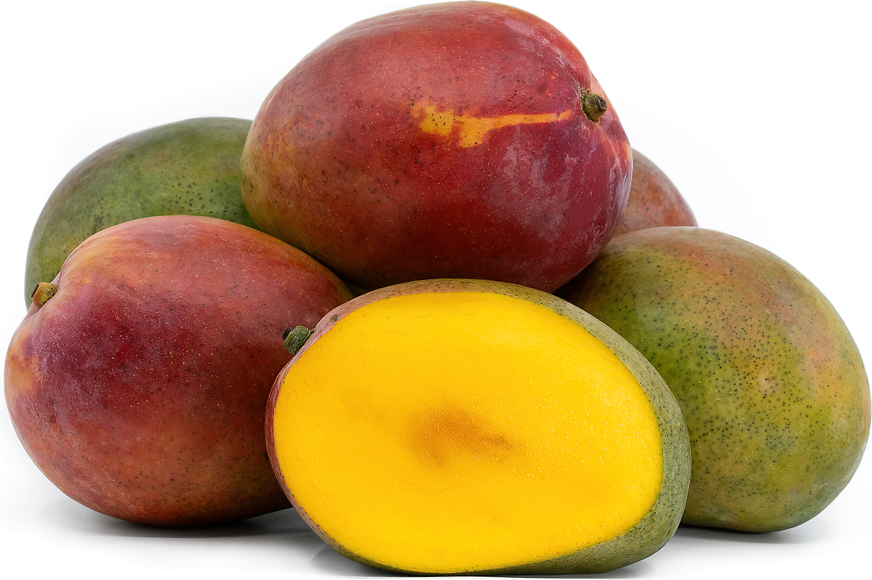


Tommy Atkins Mangoes
Estimated Inventory, ea : 0
Description/Taste
Tommy Atkins mangoes are among the larger varieties, notable for their substantial heft, which is partly due to their dense flesh. These mangoes have an oblong shape, typically measuring 12 to 15 centimeters in length and 8 to 10 centimeters in width. Their skin displays a vibrant gradient of bright green and dark red, enhanced with orange and yellow undertones that deepen as the fruit ripens. The smooth surface is dotted with small, yellow-green pores that resemble freckles. The thick, leathery skin effectively shields the golden yellow flesh inside, which is juicy yet somewhat fibrous, surrounding a large brown pit that occupies a significant portion of the mango. Tommy Atkins mangoes emit a mild, subtly sweet aroma with tropical fruit and citrus notes. Their flavor is gently sweet with a touch of tartness, both in aroma and taste, which are considered less intense compared to other mango varieties.
Seasons/Availability
Tommy Atkins mangoes are typically available from March through July, and then again from September through October.
Current Facts
Tommy Atkins mangoes, botanically classified as Mangifera indica, belong to the Anacardiaceae family. This variety is the most widely grown commercial mango imported into the United States. The trees are vigorous growers characterized by a vertical growth habit and an open canopy, allowing them to produce well even under marginal conditions. However, they are somewhat susceptible to bacterial spot and rot fungi. Notwithstanding these challenges, Tommy Atkins mangoes are favored for their long shelf life, making them particularly suitable for commercial distribution.
Nutritional Value
Tommy Atkins mangoes are an excellent source of vitamin C and vitamin A, and they also provide a good amount of dietary fiber. They contain vitamins B9 (folate) and B6, which are essential for healthy cell growth, metabolism, and brain development and function. These mangoes are rich in potassium, calcium, and iron, nutrients that support muscle and nerve function, bone health, and energy production, while also decreasing the risk of anemia. Like most mango varieties, Tommy Atkins mangoes contain enzymes that aid in digestion. Individuals who are sensitive to poison ivy or poison oak should handle mango skin with care, as it can cause irritation.
Applications
Tommy Atkins mangoes can be eaten fresh or cooked. As the skin and sap may cause irritation for some people, it is advisable to wear gloves when handling or peeling the fruit. Once peeled and deseeded, Tommy Atkins mangoes can be sliced and enjoyed fresh, incorporated into fruit salads, or diced into pico de gallo to add a tropical twist. The diced fruit can also be pureed for beverages or used in desserts such as mango upside-down cake or panna cotta. Whether pureed or left in chunks, Tommy Atkins mangoes enhance marinades and sauces for chicken, fish, or meats. Grilled Tommy Atkins mango complements barbecued poultry and pork. For a vibrant addition to fish tacos or as a garnish, mix the mango with diced red peppers, red onions, and cilantro to create a mango salsa. Tommy Atkins mangoes pair well with a variety of flavors including lime, lemon, orange zest, cinnamon, ginger, nutmeg, mint, basil, jalapeño, red chili flakes, coconut, yogurt, and various fruits like pineapple, papaya, and banana. Tommy Atkins mangoes can be stored in the refrigerator for up to three weeks, or kept at room temperature until they ripen.
Ethnic/Cultural Info
The Tommy Atkins mango, a seedling of the 'Haden' mango, originated in Florida during the 1920s. Haden was among the first superior mango varieties cultivated in the state. The variety is named after Thomas Atkins, who repeatedly submitted the 'Tommy Atkins' mango to the Florida Mango Forum, seeking its acceptance for commercial production. Although the new variety initially failed to impress the tasting panel due to its fibrous flesh and "unremarkable" eating quality, Florida mango growers recognized its potential. The mango's appealing appearance, consistent and heavy yield, disease resistance, and extended shelf life won them over. Eventually, Tommy Atkins became the predominant commercial mango variety in Florida, significantly boosting the state's mango commercialization efforts. This mango variety also gained prominence in Latin America, where it became the primary mango of commercial trade in the Western Hemisphere, alongside other Florida-discovered varieties such as Haden, Kent, and Keitt, all of which are now extensively cultivated in Latin America.
Geography/History
Tommy Atkins mangoes were first discovered in Ft. Lauderdale, Florida in the early 1920s and are now cultivated in countries like Mexico, Peru, Ecuador, Brazil, and Hawaii, with many exported to the United States. They thrive in tropical and subtropical climates that provide ample sun exposure. Tommy Atkins mangoes are not commonly found in the wild and are instead cultivated in commercial orchards and home gardens. They gained popularity as a replacement for the Haden mango, which, while once favored, faced challenges such as susceptibility to fungus, a smaller size, and a shorter shelf life. The Tommy Atkins variety offered better profitability for farmers and more competitive pricing for consumers, contributing to increased mango consumption. Today, Tommy Atkins is one of the most popular mango types in the United States, readily available in most grocery stores and suitable for cultivation in sunny, tropical garden environments.
Recipe Ideas
Recipes that include Tommy Atkins Mangoes. One
| Kitchen At Hoskins |
|
Baked Mangoes with Honey Nut Streusel |
| Medical Medium |
|
Pineapple & Apple Chips With Spicy Mango Salsa |
| Fascinating Food Wrold |
|
Mango Chili Lemonade |
| Much Butter |
|
Mango Pie |
Podcasts

















